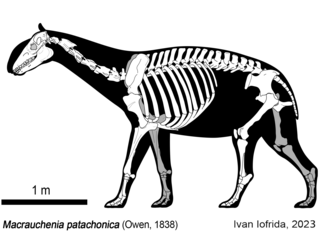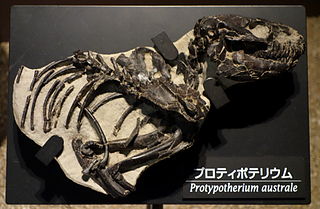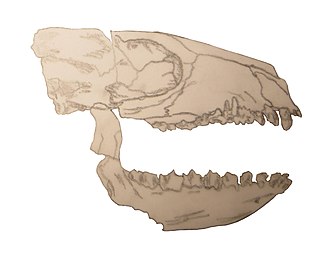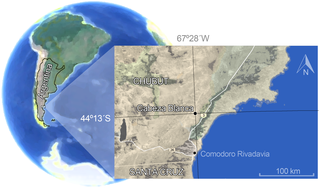
Litopterna is an extinct order of South American native ungulates that lived from the Paleocene to the end of the Pleistocene-early Holocene around 63 million-12,000 years ago, and were also present in Antarctica during the Eocene. They represent the second most diverse group of South American ungulates after Notoungulata. It is divided into nine families, with Proterotheriidae and Macraucheniidae being the most diverse and last surviving families.

Macrauchenia is an extinct genus of large ungulate native to South America from the late Pliocene to the end of the Pleistocene. It is a member of the extinct order Litopterna, a group of South American native ungulates distinct from the two orders which contain all living ungulates which had been present in South America since the early Cenozoic, over 60 million years ago, prior to the arrival of living ungulates in South America around 2.5 million years ago as part of the Great American Interchange. The bodyform of Macrauchenia has been described as similar to a camel, being one of the largest-known litopterns, with an estimated body mass of around 1 tonne. The genus gives its name to its family, Macraucheniidae, which like Macrauchenia typically had long necks and three-toed feet, as well as a retracted nasal region, which in Macrauchenia manifests as the nasal opening being on the top of the skull behind the eye sockets. This has historically been argued to correspond to the presence of a tapir-like proboscis, though recent authors suggest a moose-like prehensile lip or a saiga antelope-like nose to filter dust are more likely.

Xenungulata is an order of extinct and primitive South American hoofed mammals that lived from the Late Paleocene to Early Eocene. Fossils of the order are known from deposits in Brazil, Argentina, Peru, and Colombia. The best known member of this enigmatic order is the genus Carodnia, a tapir-like and -sized animal with a gait similar to living African elephants.

Theosodon is an extinct genus of litoptern mammal from the Early to Middle Miocene of South America.

Protypotherium is an extinct genus of notoungulate mammals native to South America during the Oligocene and Miocene epochs. A number of closely related animals date back further, to the Eocene. Fossils of Protypotherium have been found in the Deseadan Fray Bentos Formation of Uruguay, Muyu Huasi and Nazareno Formations of Bolivia, Cura-Mallín and Río Frías Formations of Chile, and Santa Cruz, Salicas, Ituzaingó, Aisol, Cerro Azul, Cerro Bandera, Cerro Boleadoras, Chichinales, Sarmiento and Collón Curá Formations of Argentina.

Cramauchenia is an extinct genus of litoptern South American ungulate. Cramauchenia was named by Florentino Ameghino. The name has no literal translation. Instead, it is an anagram of the name of a related genus Macrauchenia. This genus was initially discovered in the Sarmiento Formation in the Chubut Province, in Argentina, and later it was found in the Chichinales Formation in the Río Negro Province and the Cerro Bandera Formation in Neuquén, also in Argentina, in sediments assigned to the SALMA Colhuehuapian, as well as the Agua de la Piedra Formation in Mendoza, in sediments dated to the Deseadan. In 1981 Soria made C. insolita a junior synonym of C. normalis. A specimen of C. normalis was described in 2010 from Cabeza Blanca in the Sarmiento Formation, in sediments assigned to the Deseadan SALMA.
Victorlemoinea is an extinct litoptern genus of the family Sparnotheriodontidae, that lived from the Early to Middle Eocene. Fossils of Victorlemoinea have been found in the Las Flores, Sarmiento and Koluel Kaike Formations of Argentina, the Itaboraí Formation of Brazil and La Meseta Formation, Antarctica.

Astrapotheria is an extinct order of South American and Antarctic hoofed mammals that existed from the late Paleocene to the Middle Miocene, 59 to 11.8 million years ago. Astrapotheres were large, rhinoceros-like animals and have been called one of the most bizarre orders of mammals with an enigmatic evolutionary history.
The Divisaderan age is a South American land mammal age, covering a period of geologic time within the Middle and Late Eocene epochs of the Paleogene. It follows the Mustersan age and is followed by the Tinguirirican age.

The La Meseta Formation is a sedimentary sequence deposited during the Eocene on Seymour Island off the coast of the Antarctic Peninsula. It is noted for its fossils, which include both marine organisms and the only terrestrial vertebrate fossils from the Cenozoic of Antarctica.
Notiolofos is an extinct genus of sparnotheriodontid ungulate from the order Litopterna. The animal lived during the Eocene, in modern-day Antarctica. The genus contains two species, N. arquinotiensis, the type species, and N. regueroi.
Sparnotheriodontidae is an enigmatic extinct family of litopterns known primarily from teeth. Sparnotheriodontids are one of two South American native ungulate clades known to have reached Antarctica, the other being astrapotheres.
Polymorphis is an extinct genus of litopterns belonging to the family Macraucheniidae. It lived during the Middle Eocene of Argentina.

Adiantoides is an extinct genus of herbivorous mammal, belonging to the order Litopterna. It lived during the Middle to Late Eocene, in South America.

The Sarmiento Formation, in older literature described as the Casamayor Formation, is a geological formation in Chubut Province, Argentina, in central Patagonia, which spans around 30 million years from the mid-Eocene to the early Miocene. It predominantly consists of pyroclastic deposits, which were deposited in a semi-arid environment. It is divided up into a number of members. The diverse fauna of the Sarmiento Formation, including a variety of birds, crocodilians, turtles and snakes, also includes many mammals such as South American native ungulates as well as armadillos, and caviomorph rodents.
Pternoconius is an extinct genus of macraucheniid litoptern from the Late Oligocene and Early Miocene of Argentina. Fossils of this genus have been found in the Sarmiento Formation of Argentina.
Guilielmofloweria is an extinct genus of proterotheriid litoptern that lived from the Middle to Late Eocene of what is now Argentina. Fossils have been found in the Sarmiento Formation of Argentina.

The Salamanca Formation is a geologic formation in the Golfo San Jorge Basin of central Patagonia that yields well-preserved, well-dated fossils from the early Paleocene. Studies of these fossils are providing new data on plant and animal diversity following the end-Cretaceous extinction event.
Tricoelodus is an extinct genus of adianthid litopterns that lived during the Late Oligocene in what is now Argentina and Bolivia. Fossils of this genus have been found in the Sarmiento Formation of Argentina and the Salla Formation of Bolivia.

The Santa Cruz Formation is a geological formation in the Magallanes/Austral Basin in southern Patagonia in Argentina and adjacent areas of Chile. It dates to the late Early Miocene epoch, and is contemporaneous with the eponymous Santacrucian age of the SALMA timescale. The Santa Cruz Formation is known for its abundance of vertebrate fossils, including South American native ungulates, as well as rodents, xenarthrans, and metatherians.



















